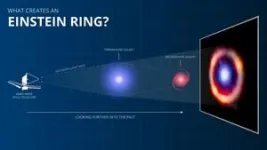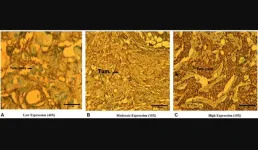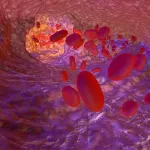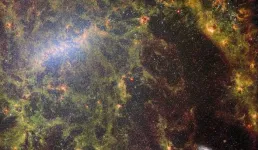(Press-News.org) Patents from the Naval Postgraduate School (NPS) are a measure of novel inventions, but each also tells a story of a relevant idea with warfighting impact. NPS Department of Physics Associate Professor Ray Gamache and his former graduate student, NPS alumnus U.S. Marine Corps Maj. Chris Phifer, developed and recently patented a new polymer-based, self-sealing fuel line capable of withstanding a .50 caliber bullet without losing so much as a single drop.
“We’re not just a physics department, we’re the applied physics department,” Gamache said. “While we’re doing things that involve fundamental research, what we’re ultimately doing is pursuing applied solutions with our military students that are important to the warfighter.”
Gamache credits the operational experience and tenacity of Phifer to develop and test multiple prototypes for his thesis to arrive at the right design of a “heterogeneous elastomer system” for a pressurized fuel line to immediately snap back into position sealing simulated combat damage.
“It was a process to build, test, learn until we got it right,” Phifer recalled. “The challenge was that I had to worry about both entry and exit points, so we created multiple 8-inch lengths of hose made from the polymers we selected, sealed on one side and a pressure fixture on the other, and found certain properties performed better on sealing the entry wound and others performed better sealing the exit wound.
“It was during the second phase of this process that we decided to incorporate multilayered polymers with opposing material characteristics, and discovered through trial and error that too many layers reduced the performance but the design with two different composites was able to self-seal.”
Self-sealing technology has been around for some time – since World War I, to be precise. Legacy systems relied on specific interactions with fossil fuels to function and thus proved obsolete with the introduction of new types of fuel. The challenge, Gamache explained, was finding the correct materials to employ.
After testing out various materials to varying effects, Gamache and Phifer found that polyureas and polythioureas worked best. Capable of 300 percent elongation – “rubber on steroids,” according to Gamache – the materials immediately “snapped back” after being pierced by the bullet.
“It isn’t rocket science,” Gamache said. “You simply need a material that has elongation and strength to it so that it has a memory of what it used to be like. When the bullet pokes a hole through it, it just goes back and pushes everything to where it used to be.”
While the research by Gamache and Phifer was initially conceived for aviation applications, Gamache noted that the technology can also apply beyond fuel lines.
“It can be any kind of line,” he said. “It’s a technology that gives you self-sealing and – most importantly – instantaneous self-sealing. There’s a lot being published on self-healing, i.e., closing up over time, but you don’t want self-healing on a fuel line because you’re going to be out of gas before long. Self-sealing is what we are after and elastomeric materials do that.”
Phifer is now stationed at U.S. Army Tank-automotive and Armaments Command (TACOM) helping develop the joint Advanced Reconnaissance Vehicle (ARV) for the Marine Corps, and agreed that the technology is important, but so is the process.
“This was a team effort with Dr. Gamache, the machine shop, the physics lab techs and even a summer high school intern,” Phifer added. “I have used what I learned from both my physics studies and my applied research process in my role with the ARV program. My time at NPS allowed me to work and understand physics and engineering concepts and develop my problem-solving skills to address the daily issues that arise in a program office.”
The research into self-sealing fuel lines may not fundamentally alter the face of modern warfare, but the technology developed has the potential to provide a marked battlespace advantage for America’s military forces. Increased survivability of warfighter and equipment, extended loiter times and decreased maintenance demands are just a few examples of this technology’s potential impact.
Entitled “Self-Sealing Hose,” the patent went public in November 2022 and is available for licensing through NPS’ Technology Transfer Program.
Innovation driven, NPS develops warfighters and warfighting solutions. about the technology patent:
https://techlinkcenter.org/technologies/self-sealing-hose/7b946c58-00de-4437-8505-e98747d7295e
The primary objective of the NPS Technology Transfer Program is to initiate partnerships with industry and/or academia, license existing technologies, and encourage and assist faculty and staff to transfer newly-developed technologies to the private sector. For more information on the program and how to work with NPS, visit https://nps.edu/web/research/technology-transfer.
END
NPS professor and student develop patented self-sealing fuel line
2023-06-05
ELSE PRESS RELEASES FROM THIS DATE:
A supervised hospital walking program may reduce nursing facility admissions for older adults
2023-06-05
1. A supervised hospital walking program may reduce nursing facility admissions for older adults
Abstract: https://www.acpjournals.org/doi/10.7326/M22-3679
URL goes live when the embargo lifts
A randomized trial of older veterans found that hospitalized persons enrolled in a supervised walking program known as STRIDE (AssiSTed EaRly MobIlity for HospitalizeD VEterans) were less likely to be discharged to a skilled nursing facility. However, the authors noted that participation in the program was low and there was no change associated with length of hospital stay or inpatient falls. The study is ...
Unraveling the mode of action of tirzepatide
2023-06-05
Tirzepatide is a recently approved treatment for type-2 diabetes. Treatment with tirzepatide decreases body weight while improving glucose metabolism in patients with obesity and type-2 diabetes. Although the drug is designed to activate receptors for glucagon-like peptide-1 (GLP-1) and glucose-dependent insulinotropic polypeptide (GIP), the contribution of activating the GIP receptor in the overall efficacy of tirzepatide is not fully understood. A team of researchers demonstrated for the first time that tirzepatide stimulates insulin secretion in the human pancreas via the GIP receptor. These results contrast with findings in ...
Study shows promising treatment for tinnitus
2023-06-05
Tinnitus, the ringing, buzzing or hissing sound of silence, varies from slightly annoying in some to utterly debilitating in others. Up to 15% of adults in the United States have tinnitus, where nearly 40% of sufferers have the condition chronically and actively seek relief.
A recent study from researchers at the University of Michigan’s Kresge Hearing Research Institute suggests relief may be possible.
Susan Shore, Ph.D., Professor Emerita in Michigan Medicine’s Department of Otolaryngology and U-M’s Departments of Physiology and Biomedical Engineering, led research on how the brain processes bi-sensory ...
BORIS gene mutation and expression: Link to breast cancer progression
2023-06-05
“The current study analyzed the correlation between BORIS mutations and the expression of the protein in breast cancer cases.”
BUFFALO, NY- June 5, 2023 – A new research paper was published in Oncotarget's Volume 14 on May 26, 2023, entitled, “Association of mutation and expression of the brother of the regulator of imprinted sites (BORIS) gene with breast cancer progression.”
The brother of the regulator of imprinted sites (BORIS), 11 zinc-finger transcription factors, ...
Healthy vascular fat during menopause may stave off dementia later in life
2023-06-05
The research, published in the journal Alzheimer’s & Dementia, is further evidence that the menopause transition is a particularly important time for women and their doctors to pay attention to heart health, in turn protecting their brain health.
“It is shocking to know that two-thirds of Americans with Alzheimer’s disease are women,” said Meiyuzhen (Chimey) Qi, first author and Ph.D. candidate in epidemiology at Pitt Public Health. “The most common modifiable risk factor for dementia is cardiovascular disease, and, interestingly, a woman’s ...
Germline genetic testing after cancer diagnosis – this study is being released to coincide with presentation at the 2023 ASCO Annual Meeting
2023-06-05
About The Study: Among patients diagnosed with cancer in California and Georgia between 2013 and 2019, only 6.8% underwent germline genetic testing. Compared with non-Hispanic white patients, rates of testing were lower among Asian, Black, and Hispanic patients.
Authors: Allison W. Kurian, M.D., M.Sc., of Stanford University in Stanford, California, is the corresponding author.
To access the embargoed study: Visit our For The Media website at this link https://media.jamanetwork.com/
(doi:10.1001/jama.2023.9526)
Editor’s Note: Please see the article for additional information, ...
A simple blood test can now diagnose De Vivo disease
2023-06-05
Glut1 deficiency syndrome is a rare and disabling neurological disease still relatively unknown to the medical community. A mutation in the SLC2A1 gene in affected patients causes the glucose transporter GLUT1 to malfunction. Since this transporter is responsible for the glucose entering glial cells, the brain is deprived of some of the sugar it needs to function correctly, leading to seizures, bouts of abnormal movement, and developmental delays.
These symptoms can be improved by managing the metabolic disorder that causes the disease via a high-fat ...
Amid volumes of mobile location data, new framework reduces consumers’ privacy risk, preserves advertisers’ utility
2023-06-05
The use of mobile technologies to collect and analyze individuals’ location information has produced massive amounts of consumer location data, giving rise to an elaborate multi-billion-dollar system in which consumers can share personal data in exchange for economic benefits. But privacy risks prevail.
In a new study, researchers used machine learning to create and test a framework that quantifies personalized privacy risks; performs personalized data obfuscation; and accommodates a variety of risks, utilities, and acceptable levels of risk-utility tradeoff. The framework ...
Early universe crackled with bursts of star formation, Webb shows
2023-06-05
Among the most fundamental questions in astronomy is: How did the first stars and galaxies form? NASA’s James Webb Space Telescope is already providing new insights into this question. One of the largest programs in Webb’s first year of science is the JWST Advanced Deep Extragalactic Survey, or JADES, which will devote about 32 days of telescope time to uncover and characterize faint, distant galaxies. While the data is still coming in, JADES already has discovered hundreds of galaxies that existed when the universe was less than 600 million years old. The team also has identified galaxies sparkling with a multitude of young, hot ...
NASA’s Webb Space Telescope peers behind bars
2023-06-05
A delicate tracery of dust and bright star clusters threads across this image from the James Webb Space Telescope. The bright tendrils of gas and stars belong to the barred spiral galaxy NGC 5068, whose bright central bar is visible in the upper left of this image – a composite from two of Webb’s instruments. NASA Administrator Bill Nelson revealed the image Friday during an event with students at the Copernicus Science Centre in Warsaw, Poland.
NGC 5068 lies around 20 million light-years from Earth in the constellation Virgo. This image of the central, bright star-forming regions ...






